Adenovirus-36 is strongly associated with Obesity (possibly prevented and treated by Vitamin D)
Reasons to believe that Adenovirus-36 is a major risk factor for Obesity
Fact: Some chickens have Adenovirus-36 (AD-36) (also Turkeys, Ducks, etc)
Fact: Birds with AD-36 gain weight
Fact: People with AD-36 antibodies are more likely to be obese than overweight
Fact: 100% of monkeys infected with AD-36 gained weight
Fact: animals (pet, lab, wild) living near humans have gained weight
Fact: Children and mice infected with AD-36 do NOT lose weight if they exercise
Fact: Adults with AD-36 antibodies weigh 50 lbs more
Fact: AD-36 alters human DNA so as to increase the number of human fat cells
Fact: If only one member of a twin is infected, only that one becomes heavier and fatter. (see 25 year overview)
Suspect: People infected with AD-36 become obese, not just overweight
Suspect: Pasture-raised chickens should be less likely to have AD-36 (better immune systems)
Suspect Prevent: Improving chicken immune system (Vitamin D or sun) will reduce % of chickens which are infected
Suspect Prevent: Improving the human immune system will reduce chance of getting the virus if eat infected chickens (or eggs?)
Fact Fight: Obese will lose 3X more weight if they add $10 of vitamin D to a weight-loss program (see below)
Note: Details of the above facts are on this page
For each increment in Adeno-36 risk of weight increase 8X if ignore vitamin D - July 2021
Is vitamin D the missing link between childhood obesity and adenovirus-36 infection?
📄 Download the PDF from Vitamin D Life
Lots of controversy - spanning 25 years
Looking for rebuttals - have not found any so far
There are, of course, many additional risk factors for Obesity such as low vitamin D
FactFight:
Obesity is associated with low Vitamin D (and treated by D as well) – Aug 2019 has the following
{include}
Obesity has increased but no Overweight increase
Suspect:
Perhaps Adeno-36 ==> Obesity, not Overweight

Obesity 2X more likely if Adenovirus - meta-analysis - 2021
Association of adenovirus 36 infection and obesity; An updated meta-analysis of community-based studies
Merical Virology 24 May 2021 https://doi.org/10.1002/rmv.2255
Arezoo Marjani,Alireza Khatami,Hassan Saadati,Milad Asghari,Mohammad Hossein Razizadeh,Aida Abbasi,Mohammad Zarei,Leila Beikzadeh,Alireza Soleimani.
As a health problem, obesity has several risk factors; it has been suggested that human adenovirus type 36 (HAdV-36) infections may possibly be associated with obesity. This updated meta-analysis was designed and conducted with an emphasis on articles published from 2015 to 2020. The PubMed, Web of Science, and Scopus databases were searched up to 1 December 2020. Overall, pooled prevalence and odds ratio of antibodies against HAdV-36 in people with obesity and controls was assessed among different ages. Case-control and cohort studies were included in the analysis. The overall prevalence of HAdV-36 infection in obese population was 31% (CI: 0.24%–0.38%) which was 32% in cases and 27% in controls, respectively; a significant association was found between the cases and the controls ( OR, 1.84 ; 95% CI, 1.39–2.43), especially in children younger than 18 years of age (OR, 2.44 ; 95% CI, 1.85–3.22). A significant association between adenovirus infection and obesity was found, especially in adolescents.
Adenovirus 36 and its effect on vitamin D levels in obese and overweight patients – Sept 2019
Infect Dev Ctries2019; 13(7):665-670.doi:10.3855/jidc.11285
Elcin Kal Cakmakliogullari1, Nurhayat Ozkan Sevencan21 Department of Medical Microbiology, Karabuk University Training and Research Hospital,Karabuk,Turkey2 Department of Internal Medicine, Karabuk University Training and Research Hospital, Karabuk, Turkey
📄 Download the PDF from Vitamin D Life

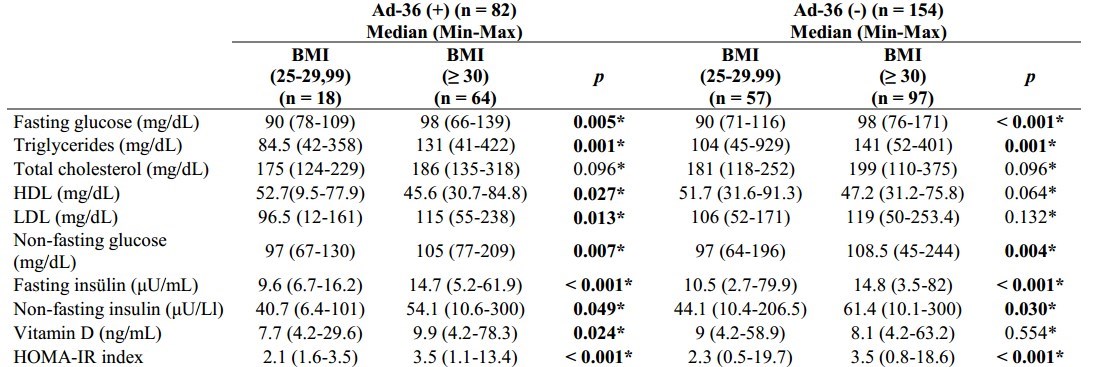
Note: Vitamin D levels were HIGHER in obese vs overweight who had Andeovirus -36 antibodies
Introduction: The aim of this study was to investigate the prevalence of Adenovirus-36 (Ad-36) in overweight and obese patients and the effects of this virus on some metabolic parameters.
Methodology: The study included 236 female patients with body mass index (BMI) ≥ 25. The patients were separated into 2 groups as overweight (BMI: 25-29.99) and obese (BMI ≥ 30). To quantitatively determine the antibody (Ab) specific to adenovirus type 36 in the serum samples, the enzyme-immunoassay (EIA) method was used (AdV36-Ab, ELISA Kit, MyBioSource). Laboratory parameters were compared between patients who are Ad-36 Ab positive and negative.
Results: Of the total 236 patients, 82 (34.7%) were determined as Ad-36 positive and 154 (65.3%) were negative. Ad-36 Ab positivity was statistically significantly higher in the obese group (p = 0.018). The HOMA-IR index, triglyceride, total cholesterol, high-density lipoprotein, and low-density lipoprotein were found to be the same in both groups with no statistically significant differences (p > 0.05). Vitamin D levels were significantly higher in BMI ≥ 30 Ad-36 Ab positive group than negative group (p < 0.05).
Conclusion: The frequency of Ad-36 Ab positivity was significantly higher in the obese group than in the overweight group. These results can be considered to shed a different perspective from previous reports in literature as only overweight and obese females were included. To the best of our knowledge, this study is the first to have shown that Ad-36 has the effect of elevating the Vitamin D
Adenovirus 36 and Obesity: An Overview - June 2015
Viruses. 2015 Jul; 7(7): 3719–3740, doi: 10.3390/v7072787
Eleonora Ponterio* and Lucio Gnessi
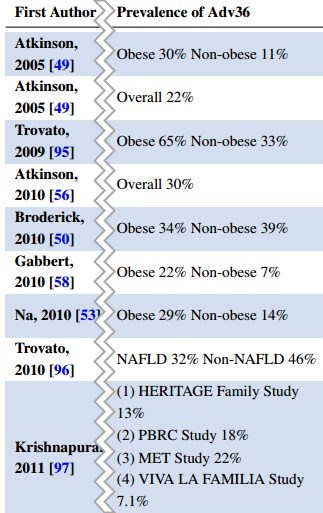
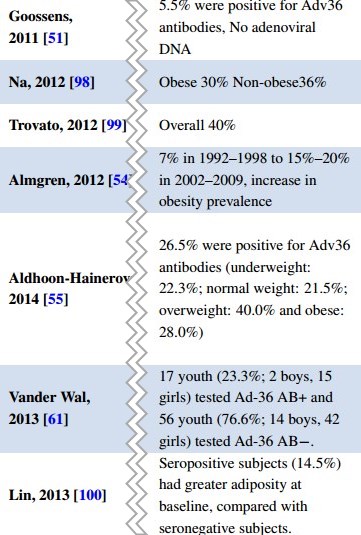
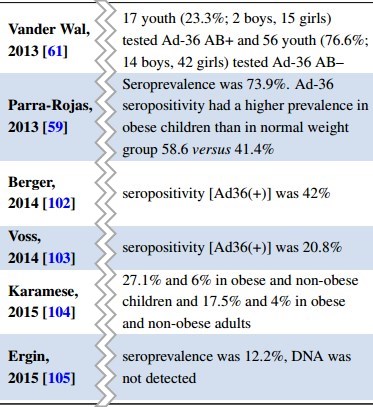
📄 Download the PDF from Vitamin D Life
Obesity Due to a Virus: How this Changes the Game
by Richard Atkinson, MD Obesity Action- date - before 2019? [[email protected]]
About the Author:
Richard Atkinson, MD, has worked in obesity treatment and research for 40 years. He is a past president of the former American Obesity Association and the North American Association for the Study of Obesity, and is the current editor of the International Journal of Obesity.
Often, educated physicians will say, “Obesity is a disease,” but not many people believe it. The government and insurance companies do not want to admit that obesity is a disease because then they would have to cover treatment as they do for other diseases . Even a large portion of healthcare professionals who treat obesity do not necessarily think of obesity as a disease. This may be because the treatments they provide are based on obesity being a behavioral problem that can only be treated by changing behaviors, such as dietary and exercise habits and lifestyle.
But, what if obesity could be “caught,” like the common cold? What if there was a virus that made experimental animals fat and was associated with obesity in humans? How would politicians and other policymakers act if they could become infected by obesity simply by being close to an infected person? Would this make any difference in healthcare policy or change the discrimination suffered by individuals affected by obesity?
What if being affected by obesity was not your fault?
Obesity Emerges as an Epidemic
Have you ever wondered why obesity all of a sudden became a problem in the United States? Why did suddenly, around 1980, the prevalence of obesity begin to skyrocket at a rate 10 times faster than from 1960 to 1980? Did you know that obesity began to skyrocket all around the world around 1980, in rich and poor countries alike?
Fast foods, sodas, TV, computers, microwaves, bigger portions, no exercise at school and lots of other things are said to have “caused” the obesity epidemic in America; however, poor countries like Paraguay and Panama do not have many of these luxuries, and certainly not as many as we do. So, why do they have a higher rate of obesity than we do? Something must have changed in the environment all around the world in a very short period of time. What could do that? The answer: an infection could do that.
Adenovirus-36 (Adv36) May Cause Obesity
There IS a virus that causes obesity. Adenovirus-36 (Adv36) is a human “common cold” virus that is easily caught from an infected person who is coughing or sneezing, or if they do not wash their hands after having a bowel movement. At least one-third of people affected by obesity have been infected and multiple investigators all around the world have started to work on this virus.
Researchers at the University of Wisconsin began experimenting with Adv36 around 1995 and found that when they experimentally infected chickens and mice, the animals increased their body fat by 50 to 150 percent. Compared to uninfected animals, about 60 to 70 percent of infected animals became affected by obesity. The investigators then tested monkeys by squirting Adv36 up their nose . This was an important experiment because Adv36 is a human virus and monkeys are the closest animal model to humans. One hundred percent of the infected monkeys gained weight.
A second experiment in a group of monkeys who had been in the animal facilities, from whom blood had been drawn and stored every six months for seven years, had Adv36 testing done on their blood. These monkeys were not deliberately infected, but all 15 became “naturally” infected throughout the seven years . Body weight was stable before infection, but once they tested positive for Adv36, they started to gain weight. The investigators speculated that their human handlers became infected and brought in the virus.
A critically important finding surprised the researchers – infected animals did NOT eat more and did NOT do less exercise, but they still gained weight. This virus causes obesity without changes in diet and exercise by changing metabolic rate and efficiency of food utilization.
Fact:
Testing Adv36 in Humans
The researchers then began to test humans, both affected by obesity as well as some not affected, in Wisconsin, New York, and Florida. The test for Adv36 is a blood test that is highly specific – if you have antibodies against Adv36, you have been exposed. More than 500 individuals were tested and the investigators found that 30 percent of the individuals affected by obesity and 11 percent of the individuals not affected by obesity had been infected. The infected people weighed more than 50 pounds more than the uninfected.
Fact:
Since these early studies, now more than 15,000 people in nine different countries have been tested for Adv36 infection. The frequency of infection varies in different countries and ranges from 6 percent in Belgium/Holland to 65 percent in Italy. All but one research group has found the prevalence of infection to be 20 percent or greater and the average is about 40 percent . Studies in adults vary, but in all six known studies in children, Adv36 was associated in some way with obesity (see chart below).
How Contagious is Adv36?
A question that invariably is asked is, “Can I catch obesity from a person affected by obesity?” The answer is that it is very unlikely to be able to catch obesity from a person who has become affected by obesity due to the virus. The difference in metabolic rate is small, so it takes quite some time to gain large amounts of weight. The animal studies have the advantage of being able to tell exactly when the animal was infected and they showed that the virus persists two months or less. It takes much longer than two months to become affected by obesity, so the virus will be gone before the person gains a lot of weight.
Scientists have determined how the ADV36 virus works.
The DNA (genetic material) of the virus gets into the fat cells of the person or animal and causes them to bring in more fat and glucose from the blood and to make fat out of the glucose. The viral DNA also causes adult stem cells in the fat tissue to turn into fat cells, so the total fat cell number increases . Thus, an infected person will have bigger fat cells and more of them. Scientists have figured out the sequence of the DNA in Adv36, which gene in the virus causes the effect, and how this gene changes the chemistry inside fat cells to cause obesity.
Fact:
What if I am Infected?
What can you do if you are infected? This is a critical question for most people, because who cares if you are infected if you cannot do anything about it? The bad news is that at the present time, there are no specific treatments for Adv36. If you are already affected by obesity, the usual problems of losing weight and keeping it off will apply.
The good news is that if you are currently not affected by obesity, it is a lot easier to prevent obesity than to treat it. Some of the anti-obesity drugs work very well to prevent weight gain. Policy changes in some states will be needed to allow Adv36 infected, non-affected by obesity people to go on obesity drugs to prevent weight gain.
More good news is that at least one paper shows that people who are infected with Adv36 lose weight better than uninfected people . So, it may be easier to lose weight; then, careful attention to diet, exercise and treatment with anti-obesity drugs may allow better weight maintenance. The bad news – people who are infected and lose weight may be more likely to gain it back more quickly if they do not pay attention to diet, activity and anti- obesity drugs.
Finally, some last good news – research is ongoing to identify antiviral agents that appear to work against Adv36 infection. And the best news of all, a vaccine has been developed that appears, in very early studies, to prevent infection with Adv36. More research is needed, but it appears that eventually, we will be able to prevent Adv36-induced obesity in those who do not have it and to treat it in those who do.
Conclusion
How will this information alter the way people affected by obesity and the disease of obesity are treated? A great deal of advocacy work is ahead to convince politicians and third-party payors to do the right thing; however, the knowledge that at least a portion of obesity is due to an infectious disease changes the entire debate.
Fact:
Lose no weight if exercise and have Adenovirus 36 (children and mice) - 2014
Adenovirus 36 Attenuates Weight Loss from Exercise but Improves Glycemic Control by Increasing Mitochondrial Activity in the Liver
PLOS ONE December 5, 2014https://doi.org/10.1371/journal.pone.0114534
Ha-Na Na ,Young-Mi Hong ,Michael B. Ye,Sooho Park,In-Beom Kim,Jae-Hwan Nam
📄 Download the PDF from Vitamin D Life
Obese children with Adenovirus 36 antibodies who exercised did not lose weight
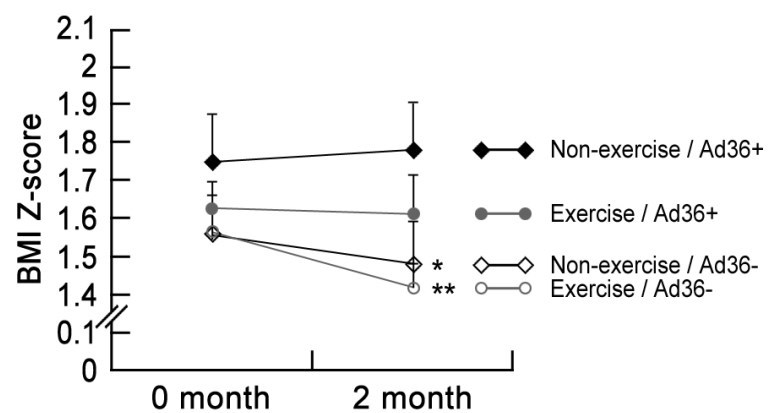
Obese Mice with Adenovirus 36 which exercised did not lose as much weight
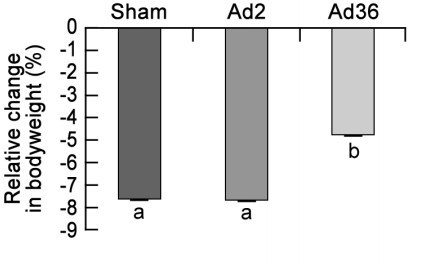
Wikipedia Adenovirusserotype36
Human adenovirus 36 (HAdV-36) or Ad-36 or Adv36 is one of 52 types of adenoviruses known to infect humans. AD-36, first isolated in 1978 from the feces of a girl suffering from diabetes and enteritis,[1] has long been recognized as a cause of respiratory and eye infections in humans.[2] It was first shown to be associated with obesity in chickens by Dr. Nikhil Dhurandhar
Role in obesity
There has been a positive correlation between body fat and the presence of AD-36 antibodies in the blood.[6] [7] Previous research showed that chickens or mice injected with similar types of viruses show a statistically significant weight gain.[3]
To date, AD-36 is the only human adenovirus that has been linked with human obesity , present in 30% of obese humans and 11% of nonobese humans.[8] In addition, a study of obese Americans indicates that about 30% of the obese individuals and only 5% of non-obese individuals have antibodies to Ad-36.[3] Another study determined that children with the virus averaged 52 pounds heavier than those with no signs of it and obese children with the virus averaged 35 pounds heavier than obese children with no trace of the virus.[9] AD-36 causes obesity in chickens, mice, rats, and monkeys also
Chickens
Virus in Chicken Could Be Linked to Obesity Greger 2016
"89,000 people in four other countries and found that animal protein intake was associated with long-term weight gain, and poultry was the worst, with 40 percent more weight gain than red meat or processed meat."
"Most studies done to date on adults have found a connection between exposure to Ad-36 and obesity, and all studies done so far on childhood obesity show an increase in prevalence of infection in obese children compared to non-obese children. We’re now up to more than a thousand children studied with similar findings. Obese children who tested positive for the virus weighed 35 pounds more than children who tested negative."
"Researchers publishing in the International Journal of Pediatric Obesity speculate that this animal adenovirus may have mutated to become a human adenovirus capable of infecting humans and causing obesity."
Increased US Chicken consumption

Note: Increased rate of chicken consumption occured during to increased obesity rate
Consumption in Europe
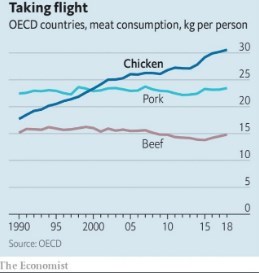
Fowl adenovirus: Using serology to control your flocks 2014

It appears that chicken farmers are very aware of Adenovirus-36.
If the chickens are not too infected they gain weight - which increases profits
Hypothesis Adenovirus and Obesity - 2016
The Microbial Hypothesis: Contributions of Adenovirus Infection and Metabolic Endotoxaemia to the Pathogenesis of Obesity
Amos Tambo, Mohsin H. K. Roshan, and Nikolai P. Pace
All three meta-analyses found an association

📄 Download the PDF from Vitamin D Life
Viruses as an Etiology of Obesity - Oct 2007 Mayo Clinic
📄 Download the PDF from Vitamin D Life
By: RICHARD L. ATKINSON, MD
Adenovirus Infection is metabolically similar to Cancer – Feb 2019
Metabolic Reprogramming of the Host Cell by Human Adenovirus Infection
Viruses 2019, 11(2), 141; https://doi.org/10.3390/v11020141
by Martin A. Prusinkiewicz 1OrcID andJoe S. Mymryk 1,2,3,4,*OrcID
📄 Download the PDF from Vitamin D Life
Human adenovirus = HAdV
Conclusions
The changes in cellular metabolism enacted by HAdV infection very closely mimic the metabolic phenotype of cancer cells. HAdV infection induces an increase in glucose and glutamine consumption to fuel glycolysis and glutaminolysis, which ultimately lead to an increase in nucleotide production for DNA replication. However, advanced metabolomic techniques have added some nuances to this understanding, as the metabolic profile of infected cells is influenced by cell density and cell type. In addition, different HAdV types modulate metabolism by different mechanisms. Although this may occur primarily through the HAdV oncoprotein E4ORF1, it potentially also occurs through the HAdV oncoprotein E1A. Understanding how this altered metabolism contributes to HAdV replication may provide the insight needed to use small molecules that influence metabolism as anti-viral therapies. In light of a recent report that HAdV may be present in a number of diverse human tumours [12], understanding the metabolic modulation of HAdV may also have potential utility for cancer treatment.


Vitamin D Life studies in both categories Obesity and Virus
{category}
Overview Obesity and Vitamin D contains the following summary
{include}
Adenovirus is mentioned at Dr. Greger's website but NOT in his bookHow Not To Diet Dec 2019
Perhaps because
He was unaware that there is something that could be done about it (Vitamin D)
He was concerned about pushback from the chicken industry
Infectobesity: Adenovirus 36 & Childhood Obesity Oct 2014
- "Most studies done to date on adults have found a connection between exposure to this virus and obesity, and all of the studies done so far on childhood obesity show an increase in prevalence of infection in obese compared to non-obese children."
Virus in Chicken Could Be Linked to Obesity June 2016
"poultry was the worst, with 40 percent more weight gain than red meat or processed meat."
"Obese children who tested positive for the virus weighed 35 pounds more than children who tested negative"
